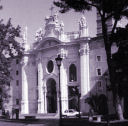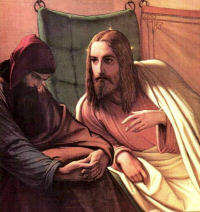Lent: March 27th
Fourth Sunday of Lent
Other Titles: Laetare Sunday
Free eBook:

|
| Free eBook: Liturgical Year 2023-2024, Vol. 4 |
» Enjoy our Liturgical Seasons series of e-books!
Entrance Antiphon, Cf. Is 66:10-11:
Rejoice, Jerusalem, and all who love her. Be joyful, all who were in mourning; exult and be satisfied at her consoling breast.
Today is the halfway mark of Lent. This Sunday is known as Laetare Sunday for the first word of the Introit or Entrance Antiphon laetare (rejoice); it is a Sunday of joy. The celebrant has the option to wear rose colored vestments. This is also the Second Scrutiny in preparation for the baptism of adults at the Easter Vigil.
Meditation on the Liturgy
This Sunday has a place apart amongst the Sundays of Lent. As in Advent we had Gaudete Sunday, so in Lent we have a Sunday commonly called Laetare Sunday. The whole week, with its wealth of liturgical significance, is intensely interesting. This Sunday in vigesimal is in imitation of Byzantine custom, a Sunday in honor of Our Saviour's Cross, for which reason the Station is at Holy-Cross-in-Jersualem, a great devotional centre in Rome, especially during Passiontide. The great part of the Mass is inspired by this choice.
Lent is half over, and Easter is enticingly near. This Sunday is our foretaste of Easter joy. Knowing the ebb and flow of intensity even in our best efforts, God deals with us tenderly in rhythms of consolation and desertion. So today, thoughts of freedom and joy come in the middle of Lent. But the joy does more than cushion our failing energies and needle our lagging spirits. It is a positive, meaningful joy, born of our fruitful life in Christ and of our sweet freedom as His purchased children. The Eucharistic banquet of heavenly Bread, foreshadowed by the multiplied loaves and fishes and become now the Bread of Life for the whole Christian world, adds to our Laetare joy the quiet gladness of every festive meal.
Sunday Mass Readings, Year C:
The First Reading is taken from the book of Joshua, 5:9, 10-12. Today's reading recounts the celebration of the Passover in the Promised Land by Joshua and those who had sojourned with him in the desert for 40 years.
The Second Reading is from the second letter of Paul to the Corinthians, 5:17-21. The reconciliation of mankind with God has been brought about by Christ's death on the cross. Jesus, who is like men in all things "yet without sinning" bore the sins of men and offered himself on the cross as an atoning sacrifice for all those sins, thereby reconciling men to God; through this sacrifice we became the righteousness of God.
The Gospel is from St. Luke 15:1-3, 11-32. This reading recounts the parable of the Prodigal Son, one of Jesus' most beautiful parables. It teaches us once more that God is a kind and understanding Father. The son who asks for his part of the inheritance is a symbol of the person who cuts himself off from God through sin. "Although the word 'mercy' does not appear, [this parable] nevertheless expresses the essence of the divine mercy in a particularly clear way" (John Paul II, Dives in misericordia, 5).
Mercy — as Christ has presented it in the parable of the prodigal son — has the interior form of the love that in the New Testament is called agape. This love is able to reach down to every prodigal son, to every human misery, and above all to every form of moral misery, to sin. When this happens, the person who is the object of mercy does not feel humiliated, but rather found again and 'restored to value'. The father first and foremost expresses to him his joy, that he has been 'found again' and that he has 'returned to life'. This joy indicates a good that has remained intact: even if he is a prodigal, a son does not cease to be truly his father's son; it also indicates a good that has been found again, which in the case of the prodigal son was his return to the truth about himself" (Dives in misericordia, 6).

Fourth Sunday in Lent (Laetare Sunday)
Station with Santa Croce in Gerusalemme (Holy Cross In Jerusalem):
This church is one of the seven pilgrim churches in Rome. St. Helen, mother of the emperor Constantine, had a church built in Rome to house the relics of the Passion of Our Lord which she had obtained during her pilgrimage to the Holy Land. St. Helen discovered the true Cross of Our Savior with its title and the instruments of His death such as the nails and the crown of thorns. She had the top layer from Mount Calvary removed and placed in barges that carried this material to Rome. She then had the builders use this soil as the ground on which she had the basilica built for the sacred relics. The true Cross and other holy items have been kept in this basilica since its consecration in the fourth century and can be visited to this day. Because of the great relic enshrined there, the basilica is called the Holy Cross and because it is built on the soil from Mount Calvary it is said to be in Jerusalem.
For further information on the Station Churches, see The Stational Church.

Fourth Sunday in Lent (Laetare Sunday)
Station with Santa Croce in Gerusalemme (Holy Cross In Jerusalem):
This church is one of the seven pilgrim churches in Rome. St. Helen, mother of the emperor Constantine, had a church built in Rome to house the relics of the Passion of Our Lord which she had obtained during her pilgrimage to the Holy Land. St. Helen discovered the true Cross of Our Savior with its title and the instruments of His death such as the nails and the crown of thorns. She had the top layer from Mount Calvary removed and placed in barges that carried this material to Rome. She then had the builders use this soil as the ground on which she had the basilica built for the sacred relics. The true Cross and other holy items have been kept in this basilica since its consecration in the fourth century and can be visited to this day. Because of the great relic enshrined there, the basilica is called the Holy Cross and because it is built on the soil from Mount Calvary it is said to be in Jerusalem.
For more on Santa Croce in Gerusalemme, see:
For further information on the Station Churches, see The Stational Church.







